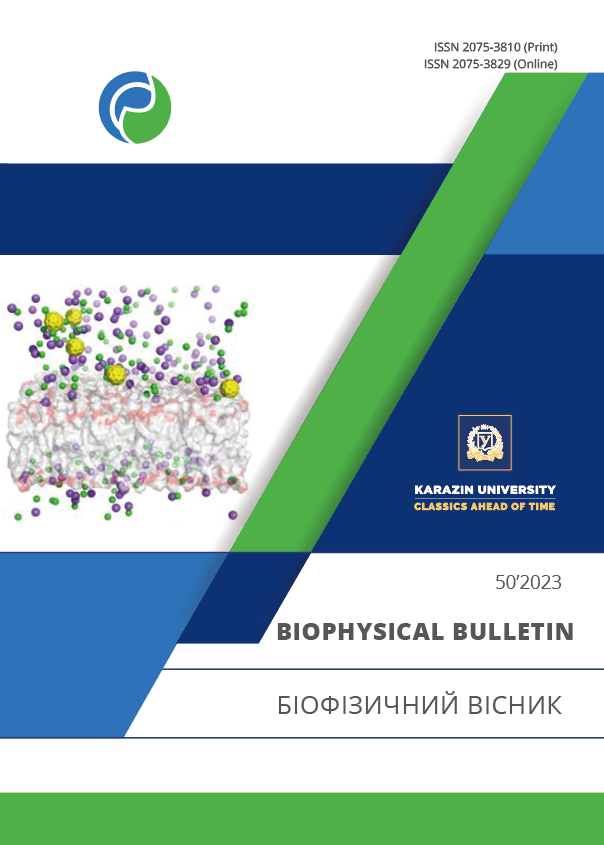C60 fullerene nanoparticles permeability through the model lipid envelope of coronavirus and their anticoronavirus effect in the in ovo system
Abstract
Background: An urgent problem of modern biomedicine is the search for potential ways to reduce the spread of coronavirus infections in human and animal populations and eliminate the impact of coronavirus on their bodies.
Aim of the work was to determine the structural organization of C60 fullerenes in a model cell medium, to assess their potential ability to penetrate the model lipid envelope of a coronavirus, thus destroying its integrity, as well as the effectiveness of the anticoronavirus action in the in ovo system.
Methods: The research was conducted using the Gromacs 2020 software package and the Charmm36 force field. The CHARMM-GUI web resource was used to construct the lipid envelope of a coronavirus. Virological and toxicological methods were used in the in ovo experiments.
Results: It is shown that at the initial stages of molecular dynamics C60 fullerene forms small nanoclusters in the amount of 7–16 molecules, which is affected by the initial concentration of C60 fullerene in a model cell medium. At the same time, the shape of nanostructures for the number of molecules over 16 may differ from the correct spherical shape. It was established that C60 fullerene and its nanoclusters are able to penetrate inside the lipid envelope of a coronavirus. In particular, a single C60 molecule can migrate, completely embed itself in the lipid envelope, or move within it. It was found that C60 fullerene aqueous solution, at the maximum permissible concentration (MPC) of 30 μg/embryo, reduces the infectious activity of the chicken infectious bronchitis (CIB) coronavirus when it is used 1, 2 and 4 h after the infection of a sensitive biological system with a coronavirus.
Conclusions: It is shown that aggregation of C60 fullerene in a model cell medium can occur in different ways: either before penetration into the lipid envelope of a coronavirus, or inside it. C60 fullerenes, both individually and as part of nanoclusters, are able to form pores in the envelope of a coronavirus, destroying its integrity, which possibly leads to disruption of the corresponding stages of its replication cycle and attachment to cell receptors. It was established that C60 fullerene aqueous solution, when used in the MPC value, shows antiviral activity against the CIB coronavirus in its early stages of interaction with the cell (1–4 h).
Downloads
References
Goodarzi S, Da Ros T, Conde J, Sefat F, Mozafari M. Fullerene: biomedical engineers get to revisit an old friend. Mater Today. 2017;20(8):460–80. https://doi.org/10.1016/j.mattod.2017.03.017
Piotrovsky LB, Kiselev OI. Fullerenes and viruses. Fullerenes, Nanotubes and Carbon Nanostructures. 2005;12(1-2):397–403. https://doi.org/10.1081/FST-120027198
Melnyk MI, Ivanova IV, Dryn DO, Prylutskyy YuI, Hurmach VV, Platonov M, et al. C60 fullerenes selectively inhibit BKCa but not Kv channels in pulmonary artery smooth muscle cells. Nanomedicine. 2019;19:1–11. https://doi.org/10.1016/j.nano.2019.03.018
Abraham MJ, Murtola T, Schulz R, Páll S, Smith JC, Hess B, et al. GROMACS: High performance molecular simulations through multi-level parallelism from laptops to supercomputers. SoftWareX. 2015;(1-2):19–25. https://doi.org/10.1016/j.softx.2015.06.001
Huang J, MacKerell Jr AD. CHARMM36 all-atom additive protein force field: validation based on comparison to NMR data. J Comput Chem. 2013;34(25):2135–45. https://doi.org/10.1002/jcc.23354
Zoete V, Cuendet MA, Grosdidier A. SwissParam: A fast force field generation tool for small organic molecules. J Comput Chem. 2011;32:2359–68. https://doi.org/10.1002/jcc.21816
Prilutski YuI, Durov SS, Yashchuk VN, Ogul’chansky TYu, Pogorelov VE, Astashkin YuA, et al. Theoretical predictions and experimental studies of self-organization C60 nanoparticles in water solution and on the support. Eur Phys J D. 1999;9(1–4):341–3. https://doi.org/10.1007/s100530050452
CHARMM-GUI Input Generator [Internet]. 2023 [cited 2023 Aug 28]. Available from: https://www.charmm-gui.org/?doc=input/membrane.bilayer
Prylutska SV, Matyshevska OP, Grynyuk II, Prylutskyy YuI, Ritter U, Scharff P. Biological effects of C60 fullerenes in vitro and in a model system. Mol Cryst Liq Cryst. 2007;468:265–74. https://doi.org/10.1080/15421400701230105
Klestova ZS, Tashuta SG, Blotska OF, Kuzmitch GS, Kubayev AP, Krasnobayev EO. Determining the infectious activity of chicken infectious bronchitis virus in chicken embryos. State Scientific and Control Institute of Biotechnology and Strains of Microorganisms of Kyiv; 2020. Methodological recommendations approved by State Service of Ukraine on Security Issues of Food and Consumer Protection on Dec 18, 2020, record 3. (In Ukrainian)
Zhang S, Mu Y, Zhang JZH, Xu W. Effect of Self-Assembly of Fullerene Nano-Particles on Lipid Membrane. PLoS ONE. 2013;8:e77436. https://doi.org/10.1371/journal.pone.0077436
Hurmach V, Platonov M, Prylutska S, Klestova Z, Cherepanov V, Prylutskyy Yu, et al. Anticoronavirus activity of water-soluble pristine C60 fullerenes: in vitro and in silico screenings. In: Asea AAA, Kaur P, eds. Coronavirus Therapeutics — Volume I. Advances in Experimental Medicine and Biology 1352. Springer; 2021. p. 159–72. https://doi.org/10.1007/978-3-030-85109-5_10
Authors who publish with this journal agree to the following terms:
- Authors retain copyright and grant the journal right of first publication with the work simultaneously licensed under a Creative Commons Attribution License that allows others to share the work with an acknowledgement of the work's authorship and initial publication in this journal.
- Authors are able to enter into separate, additional contractual arrangements for the non-exclusive distribution of the journal's published version of the work (e.g., post it to an institutional repository or publish it in a book), with an acknowledgement of its initial publication in this journal.
- Authors are permitted and encouraged to post their work online (e.g., in institutional repositories or on their website) prior to and during the submission process, as it can lead to productive exchanges, as well as earlier and greater citation of published work (See The Effect of Open Access).





